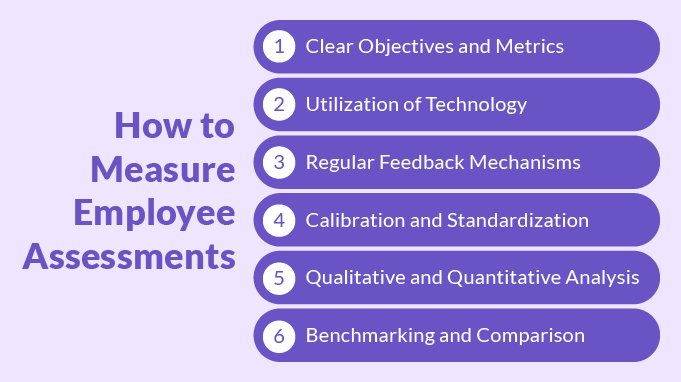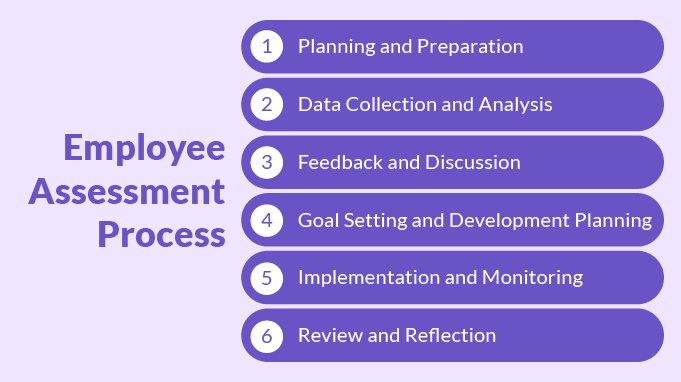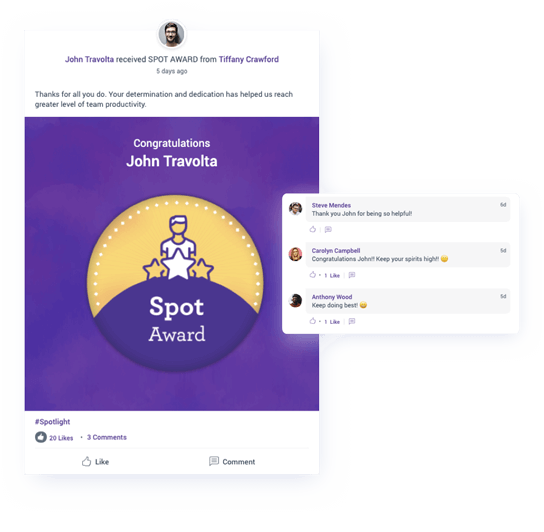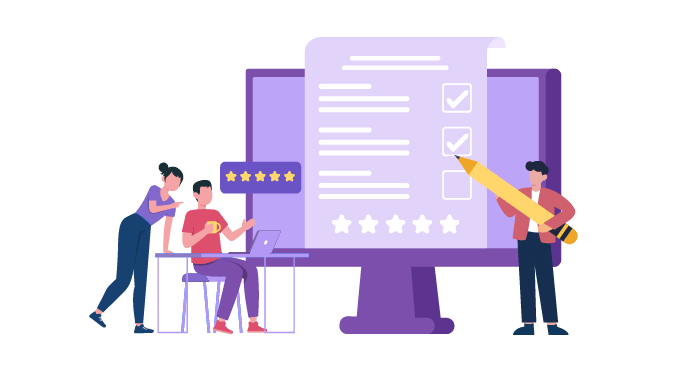Practicing Employee Assessment and its Importance
The backbone of your organization is your employees, and their overall performance matters in the long run. But keeping track of their improvement and their achievements during their tenure can become an extensive task.
However, employee assessment can help you do that if it is appropriately planned and executed well.
In this blog, we will be discussing how you can conduct employee evaluation in the right way and why it is essential.
Key Takeaways
- Understand what Employee Assessment is and why it is important.
- Types of Employee Assessment You Need to Know
- Measure Employee Assessment in the Correct manner
- Understand the Employee Assessment process.
- Best Practices to conduct Employee Assessment.
What is Employee Assessment?
It is the evaluation or performance appraisal process of an employee done regularly. Many organizations do it yearly, and some do it quarterly. This is done to focus more on an employee's progress and enhance their skills to improve further and increase engagement.
The evaluation process can become critical at times, but it is about being honest so that employees can work around their strengths and weaknesses. It is the job of an HR professional that everything goes smoothly, which has a positive impact on employees.
6 Types of Employee Assessment:
a. Performance Reviews:
Performance reviews are structured evaluations conducted periodically in an organization. It can be done monthly, quarterly, half-yearly, or annually. It is done to assess an employee's job performance, accomplishments, and key areas of improvement. A few of the critical things of such assessments include:
-
Review of past goals.
-
Feedback from supervisors and peers.
-
Discussions about future objectives.
The focal point of such assessment is to support employee development that will align with organizational objectives.
b. Skills Assessments:
Skills assessments evaluate an employees’ proficiency in specific areas relevant to their roles. It can include things like-
-
Technical expertise.
-
Soft skills.
-
Industry-specific knowledge.
These assessments can be done in the form of-
-
Test of domain skills.
-
Simulations on a particular project.
-
Practical exercises designed to measure competence.
It will help an organization to identify areas of skill gaps and strengths. Doing so will help an organization tailor training and development programs to enhance employee performance. Effective performance will ensure a higher success rate that will prove to be positive for the organizational bottom line.
c. Behavioral Assessments:
Assessing an employees’ behavior, attitudes, and interpersonal skills in the workplace is crucial. And it can be done with the help of behavioral assessment. As an employer to have a greater insight into employee behavior you can -
-
Use tools like personality assessments to understand the behavior.
-
Conduct behavioral interviews.
-
Run 360-degree feedback surveys on how they feel about the workplace.
This is done to gain insights on how individuals interact with colleagues, handle challenges, and contribute to team dynamics. In the long run, organizations can make informed decisions regarding team composition and leadership development. This will help an employer reduce any chances of conflict and maintain discipline within the workplace.
d. 360-Degree Feedback:
The main basis of 360-degree feedback involves gathering input from multiple sources. The input can be from anyone like-
-
Supervisors.
-
Peers.
-
Direct reports.
-
Stakeholders.
Their feedback will help provide a comprehensive assessment of an employees’ performance. This multi-faceted approach offers a more holistic view of strengths, weaknesses, and developmental opportunities.
By involving diverse perspectives, organizations can enhance the accuracy and fairness of performance evaluations. In the long run, it will also promote accountability and continuous improvement.
Read more: What is 360 Degree Feedback? Benefits, Best Practices, Alternatives
e. Self-Assessments:
Self-assessments allow employees to reflect on their own performance, strengths, and areas for improvement. Through self-reflection exercises, surveys, or self-evaluation forms, employees can assess their-
-
Skills.
-
Accomplishments.
-
Career aspirations independently.
-
Areas of development.
By encouraging self-assessments, organizations empower employees to take ownership and make the employees accountable. Moreover, it will give them a clear picture of their professional development, help set meaningful goals, and actively delve in learning.
f. Potential Assessments:
Potential assessments aim to identify high-potential employees. Such employees demonstrate the capability and ambition to assume greater responsibilities or leadership roles within the organization. These assessments often involve evaluating traits such as-
-
Adaptability.
-
Creativity.
-
Strategic thinking.
-
Leadership potential.
By identifying and nurturing top talent, organizations can build a pipeline of future leaders. This ensures continuity in succession planning and talent management strategies in the long run.
Why is Employee assessment Important?
Assessing your employees has become an essential part of the organization. It gives you insight into how well your employees are performing or which areas they are finding difficult to cope with. Based on the assessment data, you will be able to focus more on the skills gap bothering your employees and help them develop in their field of interest.
Thus, resulting in employee satisfaction will eventually help the organization reduce turnover rates and increase engagement in the long run.
2. How to Measure Employee Assessments:

a. Clear Objectives and Metrics:
Establishing clear objectives and measurable metrics is essential for measurement of employee assessments. Define specific goals for each assessment type, such as:
-
Improving productivity by attending mindful sessions.
-
Enhancing customer satisfaction by dealing the complex tasks first.
-
Developing leadership skills with the help of mentors.
-
Identifying key performance indicators (KPIs) that align with their job responsibility.
This will ensure that everything is tracked for a higher rate of success in the long run.
b. Utilization of Technology:
Streamline the assessment process and gather data efficiently by leveraging tools and platforms. The best thing about technology is that it can enhance accuracy, accessibility, and analyze employee capabilities with the help of AI. Performance management systems and employee engagement surveys provide the necessary assistance in generating the data. This enables organizations to make data-driven decisions and optimize employee performance.
c. Regular Feedback Mechanisms:
Communication between managers and employees is a crucial part of how employee assessments turn out to be. For a smooth workflow, implement regular feedback mechanisms. It can be done through:
-
Scheduled performance interviews.
-
Real-time feedback tools or informal check-ins.
The idea is to provide consistent feedback based on their performance. This fosters trust, transparency, and enhanced collaboration. Hence, enabling timely course corrections and continuous improvement.
d. Calibration and Standardization:
Ensure consistency and fairness in the assessment process by calibrating evaluations across teams and departments. You can do the below mentioned things:
-
Establish clear evaluation criteria.
-
Provide training for assessors.
-
Conduct regular reviews.
This will ensure reliability, validity, and fairness in assessment practices. Hence, minimizing bias and promoting accountability.
e. Qualitative and Quantitative Analysis:
Combine qualitative and quantitative analysis methods to gain a comprehensive understanding of employee performance. Quantitative data, such as performance ratings and productivity metrics, provide measurable insights. And qualitative feedback offers context, depth, and nuance to assessments. Thus, enabling more informed decision-making and personalized development strategies.
f. Benchmarking and Comparison:
Benchmark employee assessments against industry standards, best practices, and internal benchmarks. This will help gauge performance relative to peers and competitors. By comparing performance metrics, talent profiles, and engagement levels, organizations can identify trends, opportunities, and areas for improvement. This will help in driving strategic decision-making and continuous performance improvement initiatives.
3. Employee Assessment Process:

a. Planning and Preparation:
Before you assess an employee, proper planning and preparation is crucial. It ensures clarity, alignment, and agreement from all parties. You can start the assessment process by:
-
Outlining objectives.
-
Defining assessment criteria.
-
Identifying stakeholders involved.
Doing the above sets the stage for a successful assessment process within the workplace.
b. Data Collection and Analysis:
Collecting relevant data through various assessment methods can help you while assessing an employee. Some of the collecting means can include:
-
Surveys.
-
Interviews.
-
Performance evaluations.
-
Skill assessments.
It will help you identify patterns, trends, and areas for improvement. This helps in leveraging both quantitative metrics and qualitative feedback to gain actionable insights.
c. Feedback and Discussion:
After the assessment session, it is critical to provide feedback and discuss the result. Provide constructive feedback to employees based on assessment findings. Also focus on the areas for development, and actionable goals. It is necessary to foster open dialogue and collaboration between managers and employees. This ensures mutual understanding, support, and commitment to growth and development.
d. Goal Setting and Development Planning:
Moving forward, the employees should know where they are heading. Collboratively establish SMART goals and development plans based on the assessment outcome. Encourage employees to take ownership of their professional growth, provide resources and support skill enhancement. Moreover, align individual goals with organizational objectives. This will ensure that there is maximum impact while achieving the organizational goals.
e. Implementation and Monitoring:
The next step includes proper implementation and continuous monitoring of the development plans. As a leader, you need to track progress regularly to ensure accountability, effectiveness, and course corrections. It is essential to monitor milestones and provide ongoing support and feedback. To maintain enthusiasm, you can also reward and recognize them with monetary and non-monetary rewards as well.
To further enhance the recognition process you can opt for virtual recognition platforms. These are easy to use and provide hands-on accessibility.

(Source: Vantage Circle)
If things do not work out, then adjust strategies accordingly to maximize employee potential. In the long run it will help an organization to improve its bottom line.
f. Review and Reflection:
Conduct regular reviews of the assessment process to evaluate its efficacy. You need to identify strengths and areas for improvement and make necessary adjustments for future assessments. Encourage reflection among both managers and employees to celebrate successes, learn from challenges, and iterate on strategies for continuous improvement and growth.
5 Best Practices on Conducting an Employee Assessment Session

1. Plan it Out
Planning out the assessment session is vital so that you do not miss out on the crucial sections of an employee’s development. You need to curate a checklist that will help you follow up on all the things you want to discuss.
Once it is done, make sure to further discuss out with your employees what an organization needs to focus on so that employees can also enhance their performance with the exposure of the right tools.
2. Be clear about the goals
Goal setting has always been a crucial element of how employees approach their jobs. An employee with a much clearer vision of their goals is likely to achieve success in the long run.
To continue that trend, as a leader, you need to point out all the goals and objectives of the organization. Divide it and ask them to achieve it one at a time. Give them a dedicated amount of time frame and never ask them to decide in a rush. It will not only help them boost their productivity but also helps them build their confidence.
3. Transparency plays the trick
Being honest and transparent with your employees is an essential part of the assessment process. The employees need to understand the primary purpose of the assessment and the outcome that both parties want to achieve.
It is all about laying down the process in front of them and letting them know about it. It will help the employees increase their productivity with the appropriate insights. Moreover, it will make them aware on the skills gap and how one can overcome it with the help of the right training and a positive attitude.
4. Maintain consistency
For your assessment sessions to become successful in the long run, maintain consistency. Be it quarterly or yearly, it is essential to do it in time. Otherwise, your employees will feel that the system is not being fair with them regarding their performance evaluation.
Hence, consistency in conducting timely assessments does the trick for your employees to become more proficient in their job. Try to maintain focus mainly on the competencies and skills of each employee to give you a further grip on the road of being consistent. This way, it becomes easier for you, and the system remains free of bias and is fair to everyone.
5. Focus on Learning and Improvement
One of the plan of conducting evaluation sessions is to focus more on developing your employees and enhancing their performance. Ask them for feedback on where the organization is lacking in terms of providing all the necessary tools and the sections that need improvement. It should be a two-way conversation where both parties should focus on their flaws.
Moreover, it all comes down to how they can make available all the facilities to increase learning opportunities. This will not only help the employees to grow but will also increase the organization’s credibility.
6. Discussing the Future
Before concluding the session, make sure to prioritize what future work you and your employees will be doing. How it will affect both the organization and the employee and how much of a positive impact it will have.
Furthermore, give your employees the confidence that you are on their side and will always help them excel in their careers further. This will boost their morale, elevate their motivation levels, and increase engagement.
Summing it Up
Assessing your employees is a task that requires balancing criticism with praise, recognition, and setting realistic goals. While it is a tricky job to handle, however, if executed well with constructive feedback, it will motivate employees to perform better. Just be consistent with what you are doing and abolish the idea of being biased.


















